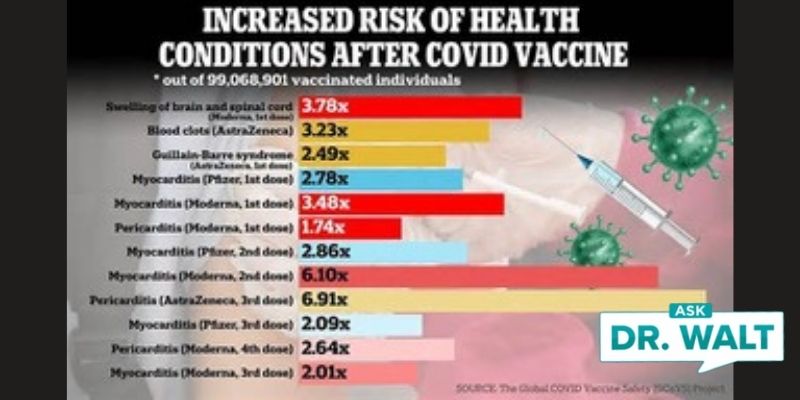Special court rules against families who claim vaccines caused autism
Barb’s Lasagna Recipe — Requested by Many of Dr. Walt’s Listeners
February 12, 2009Stimulus Bill May Change Health Care Forever
February 12, 2009According to an AP report today, a special court has ruled rather dramatically against three sets of parents with autistic children, saying that vaccines are absolutely not to blame for their children’s neurological disorder (autism). The judges in the cases said the evidence was overwhelmingly contrary to the parent’s claims — and their ruling backs years of science and mountains of evidence from around the world that found no risk for either the MMR vaccine or the vaccine preservative, thimerosal, having any role in autism or ASD.
More Information:
More than 5,000 claims were filed with the U.S. Court of Claims alleging that vaccines caused autism and other neurological problems in their children.
To win, the parents and their attorneys only had to show that it was more likely than not that the autism symptoms were directly related to the measles-mumps-rubella shots they received.
They did NOT have to prove it beyond a shadow of a doubt – which is the usual standard in court cases.
Furthermore, only the best cases, those most likely to uphold the accusation that vaccines caused autism were considered. And, not even the strongest cases held any water.
According to a Reuters story, the Vaccine Court Omnibus Autism Proceeding ruled against the parents of Michelle Cedillo, Colten Snyder and William Yates Hazlehurst, who had claimed that a measles, mumps and rubella vaccine had combined with other vaccine ingredients to damage the three children.
“Unfortunately, the Cedillos have been misled by physicians who are guilty, in my view, of gross medical misjudgment,” Special Master George Hastings, a former tax claims expert at the Department of Justice, wrote in the 183-page Cedillo ruling.
The families sought payment under the National Vaccine Injury Compensation Program, a no-fault system that has a $2.5 billion fund built up from a 75-cent-per-dose tax on vaccines.
Instead of judges, three “special masters” heard the three test cases representing thousands of other petitioners.
They asked whether a combination vaccine for measles, mumps and rubella, or MMR, plus a mercury-containing preservative called thimerosal, caused the children’s symptoms.
“The evidence does not support the general proposition that thimerosal-containing vaccines can damage infants’ immune systems,” Hastings wrote, after reviewing tens of thousands of documents and hours of oral arguments.
“I further conclude that while Michelle Cedillo has tragically suffered from autism and other severe conditions, the petitioners have also failed to demonstrate that her vaccinations played any role at all in causing those problems.”
I had expected this outcome. As long-time readers of this blog and my books know, there is just no evidence to support the claim, and literally a mountain of evidence refuting it.
I predict the same exact verdict with this same special court decides on the claim that the vaccine preservative, thimersol, caused autism.
So, know that the courts agree with the science that there is no association between vaccines and autism. Now, we all need to work toward three goals:
- Be sure that autism and ASD is diagnosed as early as possible, because the earlier the treatment the better the outcomes,
- Redouble our efforts to find the true cause or causes of autism and ASD, and
- Be sure that all children receive the safe and effective childhood immunizations that can assure they continue to be highly healthy.
Experts say parents often link vaccines with their children’s symptoms because they are vaccinated at an age when autism and related disorders are often first diagnosed.
“We need ongoing research into the causes of autism, but cannot let unfounded myths keep us from giving our children the proven protection they need against infectious diseases,” the American Medical Association said in response to the ruling.
The Institute of Medicine reviewed the evidence in 2001 and 2004, and determined there was no link between vaccines and autism. Many other studies have shown no link, but a small and vocal group of parents continues to press the case.
The advocacy group Autism Speaks said the ruling did not necessarily clear vaccines, or any other potential cause.
“We will continue to support authoritative research that addresses unanswered questions about whether certain subgroups of individuals with particular underlying medical or genetic conditions may be more vulnerable to adverse effects of vaccines,” the group said in a statement.
The judges totally and completely rejected this argument in his ruling. So should every parent.
Autism is a mysterious condition that affects as many as one in 150 U.S. children. The so-called spectrum (ASD or Autism Spectrum Disorders) ranges from mild Asperger’s Syndrome to severe mental retardation and social disability, and there is no cure or good treatment.
For more information on thimerosal from the CDC, click here. Also, see my previous blogs on thimerosal:
- Vaccine Myth #8: A Preservative Contained in Many Vaccines Harms Children
- New Study Confirms that Mercury-Based Vaccines Don’t Hurt Children and are Safe
- Vaccines: Separating fact from fiction
- Parents continue to have unwarranted fears and delusions about pediatric vaccines
Here are other blogs in this series you might find useful:
- Radio Listeners ‘Angry as Hornets’ About Dr. Walt’s Comments on Childhood Vaccination
- Doctors Debate Delayed Vaccine Schedule
- More on the Risks of Not Vaccinating Your Children
- Separating Swine Flu Myths From Facts
- Vaccine Myth #1: Vaccines Cause Autism
- Vaccine Myth #2: Vaccines Don’t Work
- Vaccine Myth #3: Vaccines Aren’t Necessary
- Vaccine Myth #4: Vaccines Are Unsafe
- Vaccine Myth #5: Infants Are Too Young to Get Vaccinated
- Vaccine Myth #6: It’s Better to Be Naturally Infected Than Immunized
- Vaccine Myth #7: Vaccines Weaken the Immune System
- Vaccine Myth #8: A Preservative Contained in Many Vaccines Harms Children
- Vaccine Myth #9: Vaccine-Preventable Diseases Occur More Often in Vaccinated People Than in Unvaccinated People
- Vaccine Myth #10: Vaccines, If Administered during the First Two Years of Life, Can Cause Diabetes
- Vaccine Myth #11: The DTP Vaccine Caused Deafness in the 1994 Miss America Beauty Pageant Winner
- Vaccine Myth #12: The Polio Virus Vaccine Is Contaminated with a Virus That Causes Cancer
- Vaccine Myth #13: Vaccinations are made from aborted babies







0 Comments
Thoughts Regarding Autism Spectrum Neurodevelopmental Disorders
Of these rare neurological disorders, Autism is the most common. The autism spectrum reflects the broad range of symptoms in which the names of these autism disorders have been given their own name for their disorder.
Autism is a disability that is suspected to be caused possibly by a brain development disorder of unknown etiology. Others suspect the cause is some sort of neurological dysfunction- possibly with a genetic predisposition. Autism is about 3 times more common in males than females as well, and it is unclear as to why this occurs.
Usually, symptoms of the disease present themselves before the toddler reaches the age of three. Before Autism was more understood, others inaccurately labeled autistic people as childhood schizophrenia or as having a psychosis or mental retardation.
Symptoms of the autistic patient included limited or dysfunctional social and personal or intimate relationships with others, their intelligence is affected, and the autistic person typically is adverse to change. Also, the autistic person tends to be compulsive and prefers to be alone. They lack eye contact as much as physical contact with other people.
Out of over two dozen diagnostic criteria utilized for these disorders, eight must be present to be considered autistic, according to the DSM. As with all passive developmental disorders, the person expresses language, social, and behavioral difficulties.
Treatment includes what are called psychotropic medications that delay the progression of the disorder, as well as relieve some of the symptoms of one who is autistic. Behavioral therapy is common as a treatment regimen as well. Boys get Autism much more than girls.
Then there is the controversy between many who claim that thimerosal- a preservative containing mercury, which is a neurotoxin that was used in vaccines until 2001, was the catalyst for autism in children.
Over 5000 lawsuits have been filed because of this belief, and some have been successful for the plaintiff. Yet most agree the correlation between thimersal and autism is void of scientific merit. Furthermore, the cases of autism have not decreased since the preservative was discontinued in 2001.
Aside from Autism, the other four passive developmental disorders are known as autism spectrum disorders.
Asperger’s Syndrome is more common than autism, and the symptoms are milder, as there is minimal delay in language abilities, if at all. What is expressed with Asperger’s syndrome is mild autistic symptoms. In time, the patient may express atypical personality disorders, though.
While intelligence is within normal limits with the Asperger’s patient, social interactions and abilities preset difficulty for such a patient. As with Autism, medications and behavioral therapy are treatment regimens with one with this syndrome
Rett’s Syndrome or disorder presents with not only atypical behavior, but also suffers from restricted physical growth and movement. There is cognitive and social impairment as well. The disorder affects mostly girls, and the cause is due to a gene mutation.
Childhood Disintegrative disorder is rare, and is 10 times less common than autism. The disorder has a late onset with mild autistic symptoms. The disorder affects mostly boys, and regression is sudden and possible with this disorder. Skills lost with this disorder may be language, social, self-care, as well as play or motor skills. Decreased function or impairment with this disorder may include social skills and behavioral flaws. Central Nervous System pathology is a suspected cause of this disorder.
Finally, there are passive development disorders that are not otherwise specified. This may include atypical autism, for example. Yet as with the rest of types of these disorders, the symptoms vary in their frequency and intensity, as well as the range of abilities of these developmental disorders vary widely as well.
Medicinal treatment is believed to be not necessary for the management of all of those who may have autistic spectrum disorders. Depending on the patient’s health care provider, medications may be prescribed by their doctor to manage any affective disorders autistics may present in an acute or chronic nature. However, cognitive and behavioral therapy prove to be most beneficial for all the different types of Passive Development Disorders that exist for reasons yet to be defined.
http://www.autism-society.org
http://www.medicalnewstoday.com/articles/139183.php
Dan Abshear